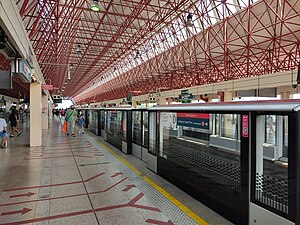
The Mass Rapid Transit system, locally known by the initialism MRT, is a rapid transit system in Singapore and the island country's principal mode of railway transportation. The system commenced operations in November 1987 after two decades of planning with an initial 6 km (3.7 mi) stretch consisting of five stations. The network has since grown to span the length and breadth of the country's main island – with the exception of the forested core and the rural northwestern region – in accordance with Singapore's aim of developing a comprehensive rail network as the backbone of the country's public transportation system, averaging a daily ridership of 3.45 million in 2023.
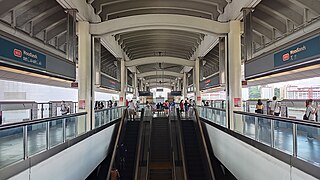
The North–South Line (NSL) is a high-capacity Mass Rapid Transit (MRT) line in Singapore, operated by SMRT Corporation. Coloured red on the Singapore rail map, the line is 45 kilometres (28 mi) long and serves 27 stations, 11 of which, between the Bishan and Marina South Pier stations, are underground. It runs from Jurong East station, located in Western Singapore, to Marina South Pier station in the Central Area, via Woodlands station in northern Singapore. The line operates for almost 20 hours a day, with headways of up to 1 to 2 minutes during peak hours and 5 to 8 minutes during off-peak hours. All the trains on the North–South Line run with a six-car formation.

The East–West Line (EWL) is a high-capacity Mass Rapid Transit (MRT) line operated by SMRT in Singapore, running from Pasir Ris station in the east to Tuas Link station in the west, with an additional branch between Changi Airport and Tanah Merah stations. It is the second Mass Rapid Transit line to be built in Singapore. Coloured green on the rail map, the line serves 35 stations, 8 of which are underground. At 57.2 kilometres (35.5 mi), the line is the longest on the MRT network.

Dhoby Ghaut MRT station is an underground Mass Rapid Transit (MRT) interchange station on the North South, North East and Circle lines in Singapore. Located beneath the eastern end of Orchard Road shopping belt in Dhoby Ghaut, Museum Planning Area, the station is integrated with the commercial development The Atrium@Orchard. The station is near landmarks such as The Istana, the MacDonald House, Plaza Singapura and Dhoby Ghaut Green.

Bishan MRT station is a Mass Rapid Transit (MRT) interchange station on the North–South (NSL) and Circle (CCL) lines in Bishan, Singapore. The station is located along Bishan Road within the town centre; it is integrated with Junction 8 shopping centre and is close to Bishan Bus Interchange. Nearby schools include Raffles Institution, Catholic High School, and Kuo Chuan Presbyterian Primary and Secondary Schools.

Boon Lay MRT station is a Mass Rapid Transit (MRT) station on the East West line (EWL) in Jurong West, Singapore. Situated along Boon Lay Way, the station is integrated with the Boon Lay Bus Interchange and Jurong Point as part of the Boon Lay Integrated Transport Hub. Other landmarks surrounding the station include the SAFRA Clubhouse and Jurong West Public Library.

Pasir Ris MRT station is an elevated Mass Rapid Transit (MRT) station on the East West line (EWL) in Pasir Ris, Singapore. Situated along Pasir Ris Central adjacent to Pasir Ris Bus Interchange and the White Sands Shopping Mall, it is the eastern terminus of the EWL. The station exterior has the characteristic dome-shaped segmented roof also seen on other elevated EWL stations.

Marina Bay MRT station is an underground Mass Rapid Transit (MRT) interchange station on the North South (NSL), Circle (CCL) and Thomson–East Coast (TEL) lines in Singapore. Located in the Downtown Core district near Marina Bay, the station serves the Marina One Residences, Marina Bay Suites and the Marina Bay Financial Centre.

Clementi MRT station is an above-ground Mass Rapid Transit (MRT) station on the East West Line (EWL). Located in Clementi, Singapore, the station is located along Commonwealth Avenue West and serves landmarks such as The Clementi Mall, Clementi Bus Interchange and Clementi Fire Station.

Orchard MRT station is an underground Mass Rapid Transit (MRT) interchange station in Singapore, on the North South (NSL) and Thomson–East Coast (TEL) lines. Situated along Orchard Boulevard and underneath ION Orchard, the station serves various commercial and retail developments of the Orchard Road shopping district, including Liat Towers, Ngee Ann City, Wheelock Place, Wisma Atria and Shaw House, among others.
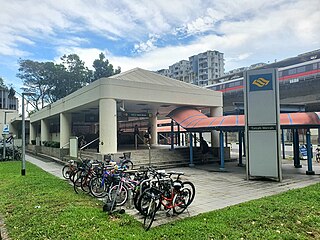
Tanah Merah MRT station is an elevated Mass Rapid Transit (MRT) station on the East West line (EWL). Located in Bedok, Singapore, the station is along New Upper Changi Road and serves various residential developments, including Casa Merah. It is the terminus of the EWL branch to Changi Airport station.

Sembawang MRT station is an elevated Mass Rapid Transit (MRT) station on the North–south line (NSL). Located in Sembawang, Singapore along Sembawang Road, the station is close to the Sun Plaza shopping centre and Sembawang Bus Interchange. The station is operated by SMRT Trains.

Kranji MRT station is an elevated Mass Rapid Transit (MRT) station on the North South line (NSL). Situated in Sungei Kadut, Singapore along Woodlands Road, it serves the Singapore Turf Club and the Woodlands Wafer Fabrication Park. The station is operated by SMRT Trains.

Woodlands MRT station is a Mass Rapid Transit (MRT) interchange station on the North–South (NSL) and Thomson–East Coast (TEL) lines in Singapore. Located in Woodlands, the MRT station was the first to feature an underground bus interchange underneath the NSL station. The station is also integrated with surrounding developments, including Causeway Point and the Woodlands Civic Centre.

Haw Par Villa MRT station is an underground Mass Rapid Transit (MRT) station on the Circle line (CCL) in Queenstown, Singapore. Located underneath West Coast Highway and Pasir Panjang Road, the station serves the nearby Haw Par Villa, alongside the Pasir Panjang Wholesale Centre.
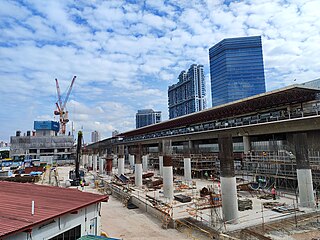
The Jurong Region Line (JRL) is a Mass Rapid Transit (MRT) line under development in Singapore. It will serve the western parts of the country, particularly the new town of Tengah and its surrounding areas. First envisioned as a Light Rail Transit (LRT) line in 2001, it was put on hold throughout the 2000s before its current iteration as a MRT line was confirmed in 2013. The line is set to open in stages from 2027 to 2029. It will be the first MRT line to be fully elevated, and the fifth MRT line to be completely automated and driverless.

Gul Circle MRT station is an elevated Mass Rapid Transit (MRT) station on the East West line (EWL). Located in Tuas, western Singapore, the station serves the surrounding industries of JTC Space @ Tuas and Mapletree Pioneer Logistic Hub. The station is operated by SMRT Trains.

Tuas Link MRT station is an elevated Mass Rapid Transit (MRT) station in western Singapore. Located in Tuas along Tuas West Drive, it is located close to Tuas Depot and Tuas Checkpoint. The station is the terminus of the East–West line (EWL) and the westernmost station in Singapore.

Choa Chu Kang MRT/LRT station is an elevated Mass Rapid Transit (MRT) and Light Rail Transit (LRT) interchange station in Choa Chu Kang, Singapore. Serving the North South line (NSL) and the Bukit Panjang LRT line (BPLRT), the station is located near the Choa Chu Kang Bus Interchange and Lot One shopping centre. Other surrounding landmarks include Keat Hong Community Club and Choa Chu Kang Park.
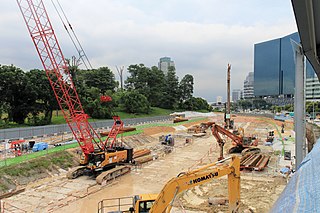
Jurong Town Hall MRT station is a future elevated Mass Rapid Transit (MRT) station on the Jurong Region Line in Jurong East, Singapore.
